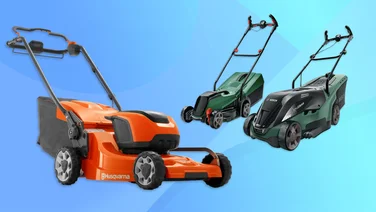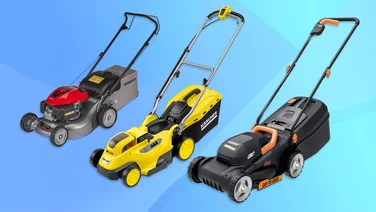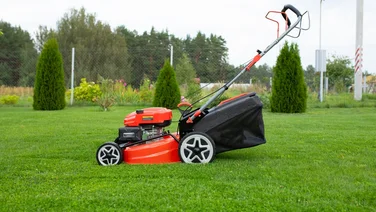To help us provide you with free impartial advice, we may earn a commission if you buy through links on our site. Learn more

In spring, due to the warmer, sunnier weather, you’ll find your lawn will start to grow pretty rapidly. Fortunately, thanks to that warmer, sunnier weather, the conditions are finally more suitable to spend some time outside, mowing your lawn.
It may be tempting to tackle the task as soon as the sun starts to shine but, before you get out there and tame that unruly growth, you’ll have to get your lawn mower out of the shed, where it has likely been mouldering for months. So, there are a few things worth checking before taking your mower for its first spin of spring and, whether it’s the oil in your petrol lawn mower or the battery on your cordless mower, giving it a once-over will ensure that it does a more effective job right now and that it won’t break down prematurely in the future.
Our checklist, below, features all of the most important things you’ll need to do to refresh your lawn mower for spring, with expert tips and advice from Paul Hicks, product and marketing manager at STIHL.
1. Clean your mower
Whether or not you care how your mower looks, giving it a thorough clean is still a good idea. This will ensure that no caked-on dirt or grass blocks any important vent or filter, and that your blade can spin freely. All of which will help prevent placing undue strain on your machine, making overheating and breakdowns less likely.
Paul Hicks makes a point of reminding users to take the necessary safety precautions: “Before you clean your mower, make sure you’re properly prepared and working safely. If your mower is cordless, remove the battery; for petrol, take out or disconnect the spark plug; and for an electric tool, disconnect the power supply. Wear sturdy gloves to protect your hands while you’re cleaning, particularly when handling the cutting blade.”
To clean your lawn mower, first remove any excess dirt and grass from the top of the mower with a stiff, dry brush, taking care to clear all debris away from the vents and filters. Next, turn the mower on its side and clear accumulated grass and dirt from the underside and the blade, always working carefully around the blade.
If possible, avoid using metal implements, as they may scratch or damage the mower. Instead, we advise using a stiff brush or rough cloth. However, if you find some of the hardened dirt or grass is proving hard to shift, you can try to pry it off using a screwdriver wrapped in a cloth or old rag.
2. Check the air filter
After being in storage for a long period, it’s important to check the air filter on your mower. As Paul notes: “The air filter on a petrol lawn mower protects the internal components of the engine from dust; they become contaminated with use, so should be checked regularly. As the filter builds up with dirt it can become less effective, and you’ll eventually find that the restricted air flow will cause engine running issues.”
Your lawn mower’s air filter will be behind a cover and can usually be found towards the front of the machine’s engine, typically on one side. If you’re having trouble finding it, try looking for your mower’s exhaust and then check for a covering on the opposite side. If you’re still having trouble finding it, or are unsure how to remove the covering, consult your manufacturer’s manual for more specific guidance.
For mowers with paper air filters, check to see if it is visibly dusty, dirty or discoloured, and if so, replace it. However, some mowers have foam filters which do not need to be replaced; instead, they can be refreshed by washing them in warm, soapy water and then allowing them to dry fully.
3. Sharpen or replace the blade
It’s generally considered best practice to sharpen your lawn mower blade about once a year, and this is the perfect time to do it. According to Paul, there are good reasons to maintain a sharp blade: “For a clean finish when cutting, it’s essential to keep your lawn mower blades sharpened. A dull blade will not cut grass effectively, tearing it and leaving a messy result. An unclean cut from a dull blade can also increase the risk of disease – and it will take longer for your lawn to recover.”
For a full explanation of how to sharpen your mower’s blade, check out our full lawn mower blade sharpening guide. Of course, if you find that your blade is too worn or blunt to sharpen, or if it has large nicks, or even cracks, from hitting stones and other garden debris, you may be better off replacing it.
4. Replace the spark plug
Your lawn mower’s spark plug will need to be replaced after roughly 25 hours of use, which works out to around once a season if you mow your lawn regularly. To replace your spark plug, we recommend following the instructions listed in your mower’s manual. It should be as simple as unscrewing the current spark plug and tightly screwing in the correct replacement part, though.
5. Change the oil and replace stale petrol
If your lawn mower is a petrol model with a separate oil reservoir then this may still be partially full from the last time you used it. However, oil degrades over time, so it is good maintenance practice to drain and replace your oil regularly.
Consult your mower’s manual if you need to work out where the oil reservoir is located, and keep an empty container on hand for collecting and disposing of the spent oil.
Similarly, if there is petrol in your machine from before winter, this may also have spoiled and should be replaced. Generally, it’s best to drain and store the fuel after each use, as petrol left standing in your machine can evaporate over time.
Paul adds: “Petrol from a standard forecourt normally contains ethanol, which is added to the fuel to make it more sustainable. Ethanol is hygroscopic, meaning it attracts moisture; this moisture can damage the internal components of your mower’s engine if left to go stale. To prevent this, I recommend draining the fuel tank before storing for long periods. Wait until the engine is cool before draining; then replace the fuel cap [and] attempt to start the machine until it doesn’t cough, so you know the tank is empty.”
6. Check the power cord for damage
If you have a corded electric mower, it’s a good idea to fully unspool and check the entire length of your power cable for damage. Mice and other pests can easily find their way into your shed and may have frayed or punctured your mower’s power cable by gnawing or scratching it. An exposed or damaged wire may not work and could be dangerous, so it’s important to assess your cable for faults, and seek out a replacement if you find any.
Paul adds a few further checks to this, offering this assessment: “No matter the kind of mower you have, a visual inspection is important to check for signs of damage before use; the owner’s manual of any lawn mower will have a full checklist of things to look out for. For a petrol lawn mower, you should check the engine oil level, and when it comes to maintaining electric mowers, it’s important to check the condition of the mower and power cable, ensuring there’s no damage to the plug or sheath. Check that the controls work for the blade (and drive) and that they move freely. If they are stiff, or don’t spring into the off position, then this needs to be fixed before using the mower.”
How to keep your lawn mower in good condition
To keep your lawn mower in good condition for next year, you’ll want to repeat many of the steps listed above before putting it into winter storage. So, aside from making sure to stow the mower in a dry, covered area, you should thoroughly clean it. If it’s a petrol model, empty its tank of any remaining fuel and check its oil level. And for cordless mowers, Paul recommends, “if your lawn mower is battery-powered, make sure to keep the battery separate from the tool, and store at a charge level of 40-60%.”






